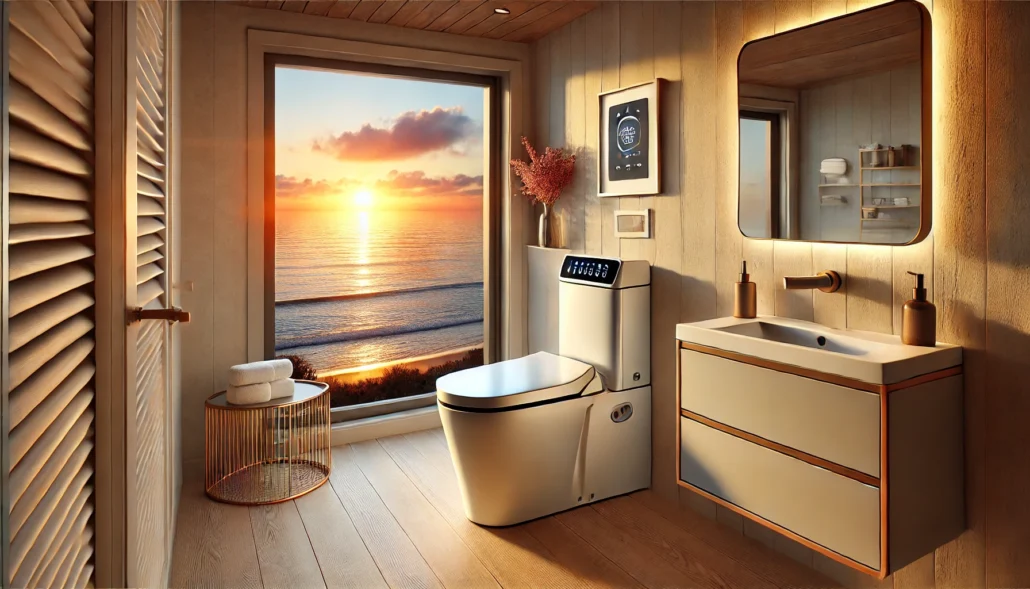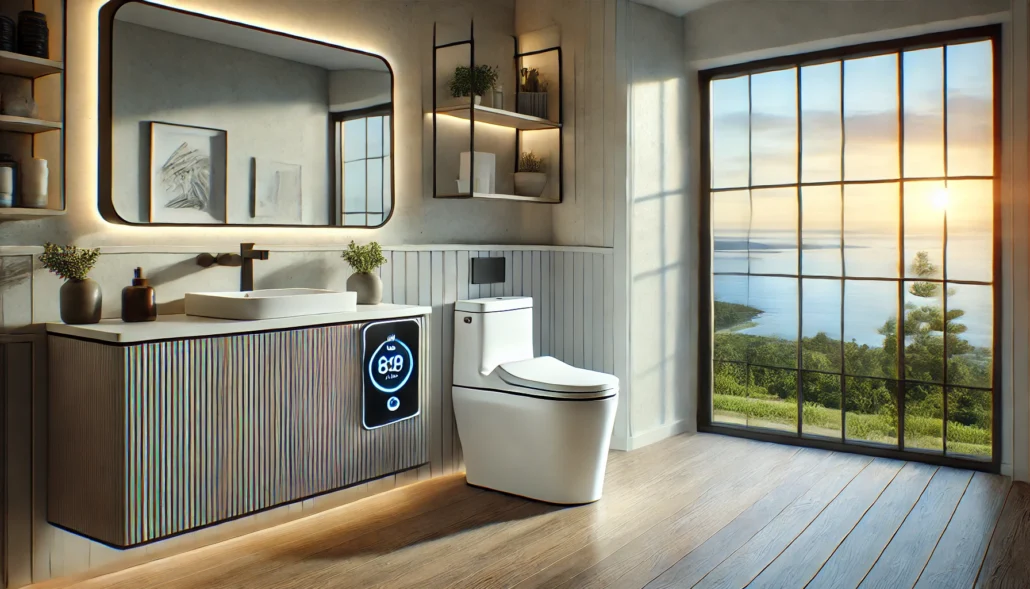Smart toilets are transforming the way we think about and use our bathrooms. These high-tech marvels combine cutting-edge technology with essential bathroom fixtures to create a more comfortable, hygienic, and efficient experience. In this comprehensive guide, we’ll explore the world of smart toilets, their features, benefits, and why they’re becoming increasingly popular in modern homes. Whether you’re considering upgrading your bathroom or simply curious about the latest innovations in home technology, this article will provide valuable insights into the smart toilet revolution.
What Exactly Is a Smart Toilet and How Does It Work?
A smart toilet is an advanced bathroom fixture that incorporates various technological features to enhance comfort, hygiene, and convenience. Unlike traditional toilets, smart toilets are equipped with sensors, electronic controls, and sometimes even artificial intelligence to provide a more luxurious and efficient bathroom experience. These intelligent toilets typically include features such as:
- Automatic lid opening and closing
- Heated seats
- Bidet functionality with adjustable water temperature and pressure
- Air dryers
- Deodorizers
- Self-cleaning capabilities
Smart toilets work by combining these features with advanced sensors and microprocessors. For example, proximity sensors can detect when a user approaches, triggering the automatic lid opening. Temperature sensors ensure the seat remains at a comfortable warmth, while pressure sensors can adjust water flow for the bidet function. Learn more about the innovative features of modern bathrooms

What Are the Key Benefits of Installing a Smart Toilet in Your Bathroom?
Installing a smart toilet in your bathroom can offer numerous advantages:
- Enhanced hygiene: With features like touchless flushing and self-cleaning nozzles, smart toilets significantly reduce the spread of germs.
- Improved comfort: Heated seats, customizable water temperatures, and air-drying functions provide a more comfortable experience.
- Water conservation: Many smart toilets use advanced flushing systems that conserve water without compromising performance.
- Accessibility: Features like automatic lid opening and adjustable height can make toilets more accessible for elderly or disabled users.
- Energy efficiency: Despite their advanced features, many smart toilets are designed to be energy-efficient, potentially lowering your utility bills.
- Customization: Users can often personalize settings like water pressure, seat temperature, and even ambient lighting to suit their preferences.
By incorporating these benefits, smart toilets can transform your daily routine and elevate your overall bathroom experience.
How Do Smart Toilets Compare to Traditional Toilets in Terms of Hygiene?
When it comes to hygiene, smart toilets offer significant advantages over their traditional counterparts:
| Feature | Smart Toilet | Traditional Toilet |
|---|---|---|
| Touchless operation | Yes | No |
| Self-cleaning capabilities | Yes | No |
| Bidet functionality | Often included | Rarely included |
| Antibacterial surfaces | Common | Uncommon |
| Deodorization | Often included | Not available |
Smart toilets typically feature touchless operation, reducing the need for physical contact with potentially contaminated surfaces. Many models also include self-cleaning functions, using UV light or electrolyzed water to sanitize the bowl after each use. The built-in bidet functionality in most smart toilets provides a more thorough and hygienic cleaning experience compared to toilet paper alone. Additionally, many smart toilets are coated with antibacterial materials and include deodorizing systems to maintain a fresher bathroom environment. Discover more about maintaining a hygienic bathroom

What Features Should You Look for When Choosing a Smart Toilet?
When selecting a smart toilet, consider the following key features:
- Bidet functionality: Look for adjustable water temperature, pressure, and nozzle position.
- Heated seat: Ensure the temperature is customizable for maximum comfort.
- Automatic lid and flushing: These features enhance hygiene and convenience.
- Energy efficiency: Check for energy-saving modes and LED lighting options.
- Remote control: A user-friendly remote can make operating the toilet more convenient.
- Self-cleaning capabilities: Features like UV sanitization or electrolyzed water cleaning can keep your toilet fresher.
- Air dryer: This can reduce or eliminate the need for toilet paper.
- Deodorizer: An built-in air purification system can keep your bathroom smelling fresh.
- Night light: Soft illumination can be helpful for nighttime bathroom visits.
- User profiles: Some high-end models allow multiple users to save their preferred settings.
Remember, not all smart toilets will have every feature, so prioritize based on your needs and budget.
Are Smart Toilets Worth the Investment?
While smart toilets typically come with a higher price tag than traditional toilets, many users find them to be a worthwhile investment. Here’s why:
- Long-term savings: Features like water-efficient flushing and reduced toilet paper usage can lead to lower utility bills and decreased household expenses over time.
- Increased home value: Smart toilets can be an attractive feature for potential homebuyers, potentially increasing your property’s value.
- Improved quality of life: The comfort and convenience offered by smart toilets can significantly enhance your daily routine.
- Health benefits: Better hygiene and features like bidet functionality can contribute to improved personal health and cleanliness.
- Accessibility: For elderly or disabled individuals, the advanced features of smart toilets can provide greater independence and comfort.
- Environmental impact: Water-saving features and reduced paper usage make smart toilets a more eco-friendly choice.
While the initial cost may be higher, the long-term benefits often outweigh the price difference for many homeowners.Explore more bathroom upgrades that can increase your home’s value

How Do You Install and Maintain a Smart Toilet?
Installing a smart toilet typically requires professional assistance due to the complexity of the electrical and plumbing connections. Here’s a general overview of the process:
- Remove the old toilet
- Install a GFCI outlet if not already present
- Connect the water supply
- Secure the toilet to the floor
- Connect the electrical components
- Test all features
Maintenance for a smart toilet is similar to that of a traditional toilet, with a few additional considerations:
- Regularly clean the bidet nozzles and other electronic components according to the manufacturer’s instructions
- Replace batteries in the remote control as needed
- Update the toilet’s firmware if applicable
- Schedule professional maintenance checks to ensure all electronic features are functioning correctly
Proper installation and maintenance will ensure your smart toilet continues to function optimally for years to come.
What Are Some Common Concerns About Smart Toilets?
Despite their many benefits, some people have concerns about smart toilets:
- Cost: Smart toilets are generally more expensive than traditional toilets.
- Complexity: Some users worry about the learning curve associated with operating a high-tech toilet.
- Dependence on electricity: Most smart toilets require a power source to operate their advanced features.
- Privacy concerns: As with any smart device, there are concerns about data collection and potential hacking.
- Repairs and maintenance: Fixing a smart toilet may require specialized knowledge and potentially costly replacement parts.
While these concerns are valid, many manufacturers are actively working to address them through improved design, enhanced security features, and comprehensive warranty coverage.
How Are Smart Toilets Changing the Bathroom Industry?
Smart toilets are revolutionizing the bathroom industry in several ways:
- Driving innovation: The popularity of smart toilets is encouraging manufacturers to develop new technologies and features.
- Shifting consumer expectations: As more people experience smart toilets, expectations for bathroom comfort and hygiene are evolving.
- Influencing bathroom design: The integration of smart toilets is changing how bathrooms are planned and constructed.
- Promoting water conservation: Advanced flushing systems in smart toilets are setting new standards for water efficiency.
- Enhancing accessibility: Smart toilet features are making bathrooms more usable for people with mobility issues or disabilities.
As the technology continues to advance, we can expect to see even more profound changes in bathroom design and functionality.Read more about the latest trends in bathroom technology

What Does the Future Hold for Smart Toilet Technology?
The future of smart toilet technology looks promising, with several exciting developments on the horizon:
- Health monitoring: Some companies are developing toilets that can analyze waste to provide health insights.
- Voice control: Integration with smart home systems may allow for voice-activated toilet functions.
- Personalized experiences: AI could enable toilets to recognize individual users and automatically adjust settings.
- Sustainable materials: Future smart toilets may be made from more eco-friendly and durable materials.
- Enhanced cleaning technologies: New methods for keeping toilets clean and sanitary are constantly being developed.
As technology continues to advance, we can expect smart toilets to become even more intelligent, efficient, and integral to our daily lives.
How Do Different Brands of Smart Toilets Compare?
When considering a smart toilet purchase, it’s important to compare different brands and models. Here’s a brief overview of some popular smart toilet brands:
- TOTO: Known for their high-quality products and innovative features like their ewater+ sanitizing system.
- Kohler: Offers a range of smart toilets with sleek designs and advanced functionality.
- American Standard: Provides affordable smart toilet options with essential features.
- Ove Decors: Focuses on luxury smart toilets with comprehensive feature sets.
- Bio Bidet: Specializes in bidet seats that can transform regular toilets into smart ones.
When comparing brands, consider factors such as:
- Feature set
- Price range
- Warranty coverage
- Customer support
- User reviews
Remember that the best smart toilet for you will depend on your specific needs, preferences, and budget. Find out more about choosing the right toilet for your bathroom

In conclusion, smart toilets represent a significant leap forward in bathroom technology, offering enhanced comfort, hygiene, and efficiency. While they come with a higher initial cost and some potential concerns, many users find the benefits well worth the investment. As technology continues to advance, we can expect smart toilets to become increasingly sophisticated and commonplace in homes around the world.Key points to remember:
- Smart toilets offer features like heated seats, bidet functionality, and automatic flushing
- They can improve hygiene, comfort, and accessibility in the bathroom
- Installation typically requires professional assistance
- Regular maintenance is crucial for optimal performance
- The future of smart toilets includes potential health-monitoring capabilities
- When choosing a smart toilet, consider your specific needs and compare different brands
By understanding the capabilities, benefits, and considerations of smart toilets, you can make an informed decision about whether this innovative technology is right for your home.


